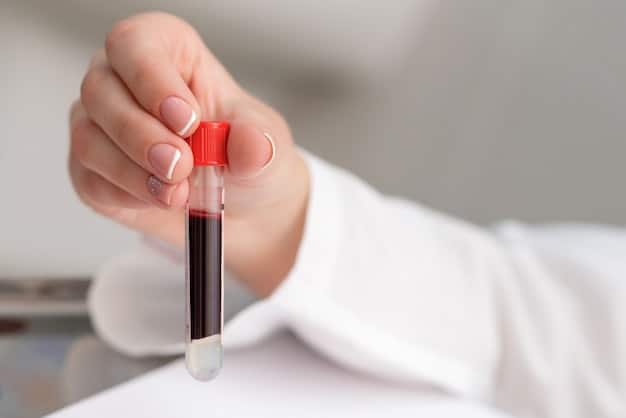Vitamin D Supplements: Right Dose in 2025?

Navigating the optimal dosage for vitamin D supplements in 2025 mandates understanding individual needs, evolving scientific consensus, and the critical balance between deficiency correction and avoiding toxicity for effective health outcomes.
In 2025, the evolving landscape of nutritional science brings to light a critical question for many: The Truth About Vitamin D Supplements: Are You Taking the Right Dose in 2025? As research progresses, our understanding of this vital nutrient deepens, making it paramount to re-evaluate current supplement practices to ensure efficacy and safety. This exploration delves into the nuances of vitamin D, offering insights grounded in the latest scientific perspectives to help individuals make informed decisions about their health.
The Enduring Importance of Vitamin D in 2025
Vitamin D, often dubbed the “sunshine vitamin,” continues to be a central figure in discussions about public health. Its role extends far beyond bone health, encompassing immune function, mood regulation, and even chronic disease prevention. In an era where indoor lifestyles and sunscreen use limit natural sun exposure, supplementation has become a routine for many, yet the specifics of optimal intake remain a moving target.
The global prevalence of vitamin D insufficiency highlights the ongoing challenge. Factors like geographical location, skin pigmentation, age, and dietary habits all contribute to varying levels within populations. As we move further into the 21st century, personalized health approaches gain traction, emphasizing that a one-size-fits-all dosage may no longer be adequate, or even appropriate, for everyone.
Beyond Bones: Multifaceted Roles of Vitamin D
While vitamin D’s primary role in calcium absorption and bone mineralization is well-established, contemporary research continues to uncover its wider systemic impact. This vitamin, which functions more like a hormone, interacts with receptors found in almost every cell in the body, influencing a multitude of physiological processes.
- Immune System Modulation: Vitamin D plays a crucial role in immune response, helping the body fight off infections and potentially mitigating autoimmune conditions.
- Cardiovascular Health: Emerging evidence suggests a link between optimal vitamin D levels and reduced risk factors for cardiovascular disease, including blood pressure regulation.
- Mental Well-being: Studies indicate a correlation between vitamin D deficiency and mood disorders, including seasonal affective disorder and depression, suggesting its role in neuro-regulation.
- Metabolic Health: Research explores its influence on insulin sensitivity and glucose metabolism, hinting at a potential role in preventing type 2 diabetes.
Understanding these diverse functions underscores why maintaining adequate vitamin D levels is more critical than ever, shifting the focus from mere deficiency prevention to optimizing overall health and resilience.
Understanding Deficiency: When Supplements Become Necessary
Identifying vitamin D deficiency is the first step toward effective supplementation. Blood tests measuring 25-hydroxyvitamin D (25(OH)D) levels are the gold standard for assessment. While optimal levels are a subject of ongoing debate, most health organizations define deficiency as 25(OH)D levels below 20 ng/mL (50 nmol/L) and insufficiency between 20-30 ng/mL (50-75 nmol/L).
However, what constitutes “optimal” often depends on individual health goals and medical conditions. Some experts advocate for higher thresholds, particularly for those with specific health concerns or living in regions with minimal sun exposure. Therefore, a dialogue with a healthcare provider is essential to interpret results in the context of one’s unique circumstances.
For many, particularly in colder climates or those with darker skin tones, relying solely on sun exposure for adequate vitamin D is impractical or insufficient. Dietary sources, though helpful, often don’t provide enough to meet daily requirements, especially when addressing a deficiency. This is where supplementation becomes a cornerstone of treatment and maintenance.

Navigating Dosage Recommendations: Evolution in 2025
The question of the “right dose” is complex, having evolved significantly over the years and continuing to be refined in 2025. Standard dietary reference intakes (DRIs) from organizations like the Food and Nutrition Board of the Institute of Medicine (IOM) traditionally recommend 600 international units (IU) per day for most adults, with an upper limit of 4,000 IU/day. However, a growing body of research suggests these recommendations might be too conservative for achieving optimal health benefits, particularly in deficient individuals.
Many experts now advocate for higher daily intakes, ranging from 1,000 IU to 4,000 IU for general maintenance, and significantly higher doses (e.g., 5,000 IU to 10,000 IU daily for several weeks or months) to correct deficiencies under medical supervision. The rationale for these higher doses stems from observations that many individuals do not reach sufficient blood levels with lower intakes, especially those with pre-existing conditions or certain genetic predispositions.
Factors Influencing Individual Dosage Needs
Determining the appropriate vitamin D dose is a highly individualized process, influenced by a myriad of factors. What works for one person may not be effective, or even safe, for another. Understanding these variables is crucial for personalizing supplementation strategies in 2025.
- Baseline Vitamin D Levels: Individuals with severe deficiencies naturally require higher loading doses to replete their stores, followed by a maintenance dose.
- Sun Exposure: Limited exposure due to geographical location, lifestyle, or clothing heavily increases the reliance on supplements.
- Skin Pigmentation: Darker skin tones produce less vitamin D from sun exposure due to higher melanin content, increasing their risk of deficiency.
- Body Weight: Higher body mass index (BMI) is associated with lower circulating vitamin D levels, often necessitating higher doses.
- Age: The skin’s ability to synthesize vitamin D decreases with age, making older adults more susceptible to deficiency.
- Dietary Intake: While natural dietary sources are limited, some fortified foods contribute to overall intake.
- Medical Conditions: Conditions affecting fat absorption (e.g., Crohn’s disease, celiac disease, cystic fibrosis, gastric bypass surgery) or kidney function can impair vitamin D absorption or metabolism.
- Medications: Certain medications, such as some anticonvulsants, corticosteroids, and weight-loss drugs, can interfere with vitamin D metabolism.
Given this complexity, the idea of a universal “right dose” becomes increasingly misleading. It emphasizes the need for a targeted approach, guided by professional advice and regular monitoring.
The Risk of Excess: Toxicity and When to Be Cautious
While vitamin D deficiency is widespread, it’s also important to acknowledge the potential for toxicity, though it is far less common. Vitamin D is a fat-soluble vitamin, meaning excess amounts are stored in the body, primarily in fat cells. Unlike water-soluble vitamins, which are excreted in urine, excessive vitamin D can accumulate to toxic levels. This condition, known as hypervitaminosis D, typically occurs from taking extremely high doses of supplements, often 10,000 IU/day or more over prolonged periods, and almost never from sun exposure or food alone.
Symptoms of vitamin D toxicity are primarily related to hypercalcemia (excessively high blood calcium levels), as vitamin D enhances calcium absorption. These can include nausea, vomiting, weakness, frequent urination, loss of appetite, constipation, and in severe cases, kidney damage, soft tissue calcification, and heart rhythm abnormalities. Monitoring blood calcium levels, along with 25(OH)D levels, is crucial for those on high-dose supplementation.
For individuals without a confirmed deficiency, adhering to the established upper tolerable intake levels (ULs)—currently 4,000 IU/day for most adults—is a prudent approach to prevent accidental overdose. However, under medical supervision to correct a significant deficiency, higher doses for a limited period may be prescribed and safely managed.
Vitamin D Supplement Forms: Oral vs. Dermal, and Interactions
The market offers various forms of vitamin D supplements, primarily D2 (ergocalciferol) and D3 (cholecalciferol). While both forms can raise vitamin D levels, D3 is generally considered more effective at increasing and maintaining circulating 25(OH)D levels. It’s the same form produced by the skin upon sun exposure and is thus more bioavailable. Most over-the-counter supplements for general use contain vitamin D3.
Oral supplements are the most common and effective route for increasing vitamin D levels. They come in various formulations including capsules, tablets, liquids, and chewables. For individuals with malabsorption issues, special formulations or even injectable vitamin D might be considered under medical guidance.
Topical vitamin D, delivered through skin creams, is also available but its efficacy in raising systemic levels is less consistent and generally not relied upon for treating significant deficiencies. Its absorption varies widely depending on the formulation and individual skin properties.
Beyond the form of vitamin D itself, it’s crucial to acknowledge its interactions with other nutrients and medications. Magnesium, for instance, is a critical cofactor in vitamin D metabolism; without sufficient magnesium, vitamin D supplementation may be less effective. Similarly, vitamin K2 is often discussed alongside vitamin D, as it helps direct calcium to bones and away from soft tissues, potentially mitigating some risks associated with high calcium levels from vitamin D. Individuals should also inform their healthcare providers about all supplements and medications they are taking to prevent adverse interactions.
Future Outlook for Vitamin D Supplementation in 2025 and Beyond
As we navigate 2025, the narrative surrounding vitamin D supplementation continues to evolve, driven by ongoing research and personalized medicine. The trend is moving towards more nuanced recommendations, powered by advancements in genomics and biomarker analysis that allow for a deeper understanding of individual metabolic needs.
Future guidelines are likely to incorporate more specific advice beyond simple blanket recommendations, taking into account genetic predispositions, lifestyle specificities, and individual health goals. The role of artificial intelligence in analyzing vast datasets to predict optimal dosages for individuals based on a comprehensive profile—including genomics, metabolomics, lifestyle, and existing health conditions—is also on the horizon. This personalized approach aims to optimize health benefits while rigorously minimizing risks.
Furthermore, public health initiatives will continually refine their messaging to educate populations on the importance of testing, safe supplementation practices, and the balance between natural sources and dietary intake. The conversation will likely shift from just “sufficient” levels to achieving “optimal” levels tailored to individual physiological needs and disease prevention strategies.
In essence, 2025 marks a period of refined understanding and increasingly individualized strategies for achieving adequate vitamin D status. The focus remains on informed decision-making, in partnership with healthcare professionals, to harness the full potential of this indispensable nutrient for long-term health and well-being.
| Key Point | Brief Description |
|---|---|
| ☀️ Importance | Beyond bones, vital for immune health, mood, and chronic disease prevention. |
| 📊 Dosage Needs | Highly individual; depends on baseline levels, sun exposure, weight, and health conditions. |
| ⚠️ Toxicity Risks | Rare, but possible with extremely high doses. Leads to hypercalcemia, monitor blood levels. |
| 🔮 Future Outlook | Moving towards personalized recommendations based on genetics and advanced analytics. |
Frequently Asked Questions About Vitamin D Supplements
The only reliable way to know your vitamin D status is through a blood test. Your doctor can measure your 25(OH)D levels. If they are below 20 ng/mL, you are deficient; if between 20-30 ng/mL, you are insufficient. Your healthcare provider will guide you on appropriate supplementation based on these results and your individual health profile.
While sun exposure is a primary source of vitamin D, relying solely on it can be challenging. Factors like geographical location, time of day, season, skin tone, and sunscreen use significantly affect synthesis. Many people, especially those in regions with limited sunlight or with darker skin, may not produce enough vitamin D from the sun alone to meet their needs.
Vitamin D2 (ergocalciferol) is plant-derived, while vitamin D3 (cholecalciferol) is produced in human skin upon sun exposure and found in animal products. Research suggests that vitamin D3 is more effective at raising and maintaining active circulating levels of vitamin D in the body compared to D2, making D3 the preferred supplemental form for most.
Yes, taking excessively high doses of vitamin D supplements can lead to toxicity (hypervitaminosis D). This can cause high blood calcium levels (hypercalcemia), leading to symptoms like nausea, vomiting, weakness, frequent urination, and in severe cases, kidney damage. Toxicity rarely occurs from sun exposure or food. Always consult a healthcare professional before taking high doses.
Vitamin D is a fat-soluble vitamin, meaning it’s best absorbed when taken with fat. Therefore, it’s generally recommended to take your vitamin D supplement with a meal that contains some fat. This can significantly improve its absorption and efficacy in raising your blood vitamin D levels. A large meal is not necessary; even a small amount of dietary fat is sufficient.
Conclusion
As we delve into 2025, the understanding of vitamin D’s profound impact on overall health continues to expand, moving beyond its well-known role in bone integrity to encompass immune function, mental well-being, and chronic disease prevention. The journey to determining the “right” dose of vitamin D supplements is increasingly personalized, influenced by an individual’s baseline levels, lifestyle, genetics, and specific health conditions. While widely available, the decision to supplement, and at what dosage, should always be an informed one, ideally guided by professional medical advice and regular monitoring. Ultimately, achieving optimal vitamin D levels is a crucial step towards fostering long-term health, requiring a balanced approach that combines natural sources, diet, and judicious supplementation tailored to individual needs.





